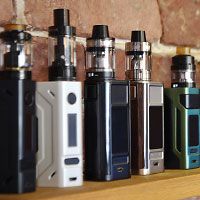Journal Digest: Aripiprazole; Specialized Therapy; Vaping; and More
Aripiprazole With Digital Sensor May Lower Hospitalization Risk

The use of aripiprazole that contains a digital sensor to verify pill ingestion may reduce psychiatric hospitalizations in adults with schizophrenia, according to a study published in the Journal of Clinical Psychiatry.
Investigators at the Hassman Research Institute in New Jersey and colleagues enrolled 277 adults with schizophrenia who had been taking oral antipsychotics for at least six months and had at least one psychiatric hospitalization in the previous 48 months; 88% were taking oral aripiprazole. All the participants were switched to aripiprazole tablets with a sensor for three months, with an option to continue for three more months or switch to another medication. The tablets contain a tiny ingestible sensor that is activated by stomach acids; sensor activity is received by a patch on the person’s skin and then transferred to a mobile app.
In total, 113 participants completed the first three-month phase of treatment with aripiprazole with a sensor (defined as taking at least 80% of their required medication). While about 10% of these participants were hospitalized in the three months before the trial’s start, no one was hospitalized in the first three months of taking aripiprazole with the sensor.
After the first phase, 84 adults opted to continue taking aripiprazole with a sensor for three more months; no participants were hospitalized during this period.
“By maximizing chances of patient success and thereby reducing rates of psychiatric hospitalization, inclusion of [aripiprazole with a sensor] in the routine care plan may help alleviate the burden on health care resources that is common in this population,” the investigators wrote.
Cohen EA, Skubiak T, Hadzi Boskovic D, et al. Phase 3b Multicenter, Prospective, Open-label Trial to Evaluate the Effects of a Digital Medicine System on Inpatient Psychiatric Hospitalization Rates for Adults With Schizophrenia. J Clin Psychiatry. 2022; 83(3): 21m14132.
Specialized Therapy May Help Depressed Women With Fibromyalgia

Personal construct therapy (PCT) may be as effective as cognitive-behavioral therapy (CBT) for treating depression in women with fibromyalgia, reports a study in the International Journal of Clinical and Health Psychology. PCT emphasizes patients’ own perceptions and interpretations of how the world works.
Researchers at the University of Barcelona and colleagues recruited 106 women with fibromyalgia and current depressive symptoms (defined as a score of greater than 7 on the Hospital Anxiety and Depression Scale, or HADS-D). The participants were randomly assigned up to 18 one-hour sessions of CBT or PCT, which were delivered by the same set of therapists. Depressive symptoms and other measures were assessed at baseline, at the end of treatment, and at six-month follow-up.
At the end of treatment, both groups of women showed statistically similar improvements in HADS-D scores (about a 3.5-point reduction). Both groups also experienced improvements in anxiety and quality of life. The similarities were maintained at the six-month follow-up.
The researchers suggested multiple reasons why these two psychotherapy modalities offered similar results: “[B]oth therapies share a focus on cognitive factors related to pain and psychological suffering. The therapies also both use modular formats that might promote symptom reduction in the same manner by adjusting to the needs of each person, as recommended for this population.”
Aguilera M, Paz C, Salla M, et al. Cognitive-Behavioral and Personal Construct Therapies for Depression in Women With Fibromyalgia: A Randomized Controlled Trial. Int J Clin Health Psychol. 2022; 22(2): 100296.
Age Laws for Vaping May Benefit Youth Mental Health

Raising the age requirements for purchasing electronic cigarettes may lead to positive mental health effects in youth, suggests a study appearing in Addiction.
Investigators at Memorial University of Newfoundland in Canada used data from two large Canadian surveys to examine the relationship between e-cigarette minimum age laws and mood and anxiety symptoms reported by youth aged 15 to 18. Between 2015 and 2017, individual Canadian provinces began requiring purchasers of e-cigarettes to be at least age 18 or 19 years; in 2018 a nationwide law established purchasers of e-cigarettes would be required to be at least 19 years old.
The survey data showed that between 2008 and 2015, the prevalence of mood or anxiety disorders increased across Canada. However, between 2015 and 2017, the prevalence of both mood and anxiety disorders decreased in the provinces that implemented a minimum age law for e-cigarettes while rates in other provinces continued to rise.
The investigators estimated that following the implementation of provincial laws, the risk of mood and anxiety disorders fell 43% and 24%, respectively, among Canadian youth in those provinces relative to youth in provinces without such laws. Youth in provinces with minimum age laws were also less likely to report cannabis use and illicit drug use following the passage of those laws.
These findings “demonstrate various benefits of the [minimum legal age] law that go beyond its direct impact of reducing e-cigarette use among youths,” the investigators wrote. “[B]y reducing e-cigarette use among youths, the [minimum legal age] law could help reduce or delay their use of nicotine and other drugs as well as alleviate peer pressure to vape, leading to improvements in their mental health.”
Nguyen HV, Mital S. Effects of E-Cigarette Use on Mental Health among Youths: Quasi-Experimental Evidence from Canada. Addiction. 2022;117(10):2673-2682.
Intensive Home Treatment May Shorten Future Hospital Stays

Intensive home treatment is a safe and viable alternative to hospitalization for people having a psychiatric crisis, according to a study appearing in Lancet Psychiatry. Though intensive home care and hospitalization produced similar outcomes, home care helped free up inpatient bed space without compromising patient safety.
The researchers compared the 12-month outcomes of 183 patients aged 18 to 65 years who received intensive home treatment following a psychiatric crisis with 63 similarly aged patients who received usual inpatient care. All participants had to have a residence in Amsterdam and no previous experience of home treatment.
After 12 months, the patients who received intensive home care spent an average of 25 fewer days in the hospital than those who received usual care (42 vs. 67 days). However, the number of hospital admissions per patient (both voluntary and involuntary), frequency of adverse events, quality of life, and satisfaction with the treatment did not differ between patients who received home care or inpatient care.
“Future research should focus on which components of intensive home treatment or hospitalisation can be used when, for whom, and meet which goals, so that both hospital care and intensive home treatment can be used proportionally and efficiently for patients in psychiatric crisis,” the researchers wrote.
Cornelis J, Barakat A, Blankers M, et al. The Effectiveness of Intensive Home Treatment as a Substitute for Hospital Admission in Acute Psychiatric Crisis Resolution in the Netherlands: a Two-Centre Zelen Double-Consent Randomised Controlled Trial.. Lancet Psychiatry. 2022; 9(8) :625-635.
PTSD Found to Increase Risk of Parkinson’s in Older Men

Men who are diagnosed with posttraumatic stress disorder (PTSD) at age 72 or later are at an elevated risk for developing Parkinson’s disease, reports a study in JAMA Network Open.
Investigators at Israel’s Tel Aviv University and colleagues made use of data from Maccabi Health Care Services (MHS), the second largest health plan in Israel. They identified 8,336 adults (51% male) born before 1970 who received a PTSD diagnosis between January 1, 2000, and December 31, 2015, and had no Parkinson’s at the time of PTSD diagnosis. Each adult with PTSD was matched with an individual of the same sex and birth year who was not diagnosed with PTSD. The participants were tracked until they were diagnosed with Parkinson’s disease, they died, they left MHS, or until the end of 2019.
Overall, 1.4% of individuals with PTSD and 0.9% without were subsequently diagnosed with Parkinson’s during the study period. After adjusting for such factors as smoking status, depression, and socioeconomic status, the investigators found that PTSD increased the risk of Parkinson’s by 48%. Additional analysis showed the risk was primarily driven by men diagnosed with PTSD at ages 72 or later, who had a 95% increased risk of Parkinson’s.
“The fact that PTSD in men older than 72 years was associated with increased risk of developing PD [Parkinson’s] later in life in our study may indicate that PTSD in older patients may actually be a prodromal symptom of PD, especially in the light of the fact that PARK2, a PD gene involved in dopamine regulation, is associated with PTSD in men,” the investigators wrote.
Barer Y, Chodick G, Glaser et al. Risk of Parkinson Disease Among Adults With vs Without Posttraumatic Stress Disorder. JAMA Netw Open. 2022; 5(8): e2225445
Misdiagnosing Bipolar I Costly for Patients

Misdiagnosing patients with bipolar I disorder as having major depression has significant clinical and economic ramifications, according to an analysis conducted by researchers at the University of Toronto and colleagues. As published in the Journal of Affective Disorders, patients with bipolar disorder who are misdiagnosed with depression have higher rates of hospitalizations, trips to the emergency room, and outpatient visits, which lead to thousands of extra dollars in health care costs for the patients each year.
The researchers used commercial insurance databases to compare the health care visits and expenditures of 14,729 adults (18 years or older) who were misdiagnosed with major depression before receiving a subsequent bipolar I (BP-I) diagnosis with 16,072 adults correctly diagnosed with BP-I. The health provider type at the time of misdiagnosis was relatively evenly distributed among mental health specialists, primary care physicians, and other providers; the average time to correct diagnosis was a little over one year.
During the roughly three-year follow-up period, the misdiagnosed adults had about twice the rate of hospitalizations as well as one-third more emergency room visits and outpatient visits compared with the correctly diagnosed adults. This led to an average of $6,500 more in health care costs annually for the misdiagnosed adults; mental health–related visits accounted for more than 85% of these costs.
“The results of this study support the clinical importance of appropriate screening and timely diagnosis of BP-I,” the researchers wrote. “Validated screening tools, such as the Mood Disorder Questionnaire (MDQ) and the newer and shorter Rapid Mood Screener (RMS) may aid health care professionals in distinguishing bipolar disorder from other mental health disorders and promote optimal treatment of patients according to the correct diagnosis.” ■
McIntyre RS, Laliberté F, Germain G, et al. The Real-World Health Resource Use and Costs of Misdiagnosing Bipolar I Disorder. J Affect Disord. 2022; 316: 26-33.



